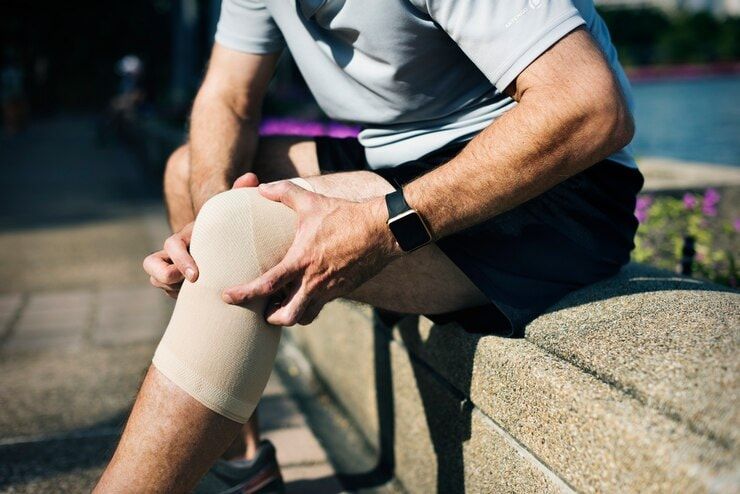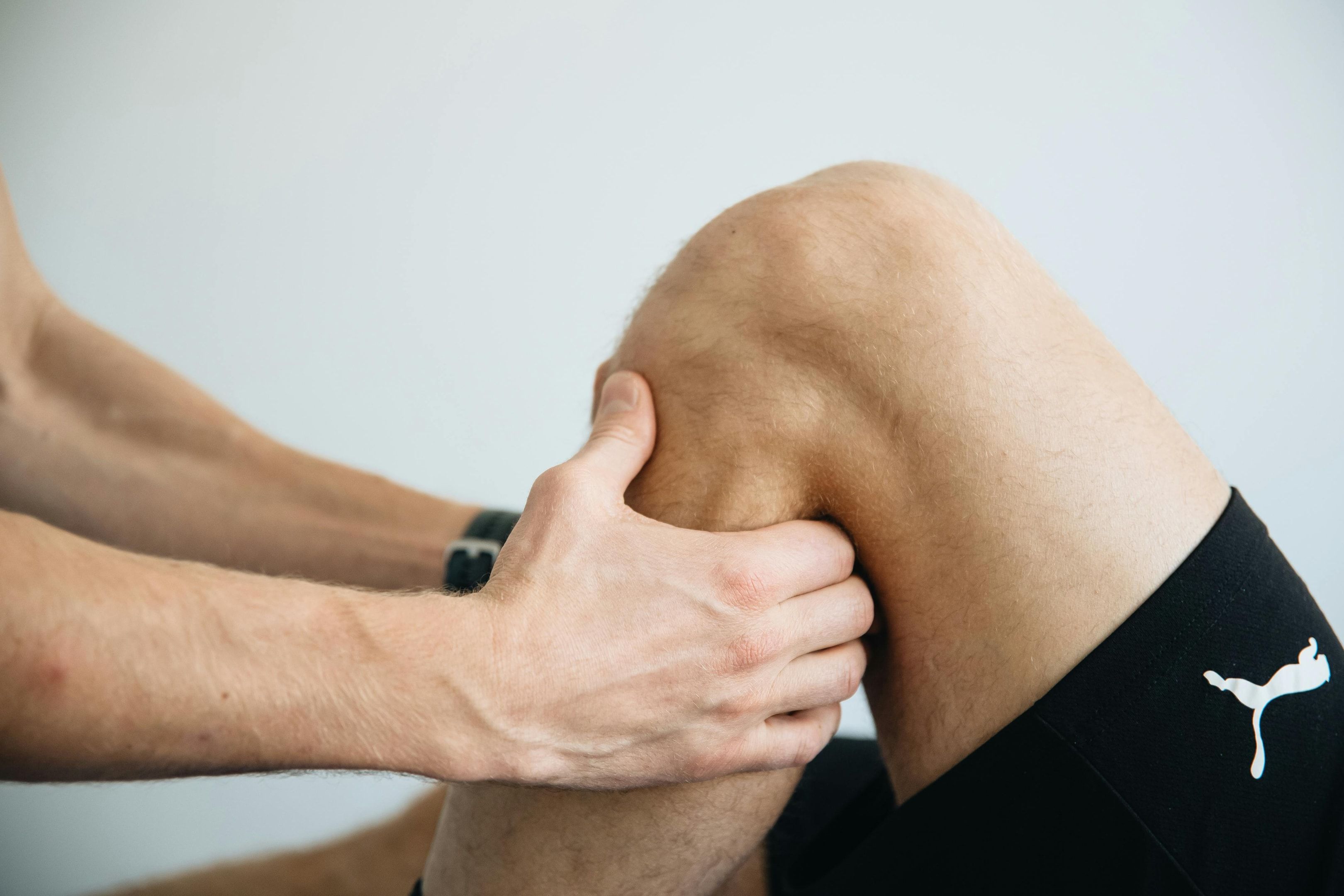How To Treat Your Knee Cartilage Injury
By Louise YowActive and sporty individuals can be more prone to knee cartilage damage considering the nature of their activities. Similarly, this risk increases as we age. However, knee cartilage injuries are more common than we might think. Since our knees support our body weight, we can easily damage them when we run, jump, climb stairs, and put them under stress.

In this guide, we'll discuss how to diagnose knee cartilage injuries and standard treatments that work.
What Are Knee Cartilage Injuries?
The knee joint is a complex structure that relies on smooth, gliding surfaces to move freely. Made of soft tissues, cartilage acts as a shock absorber and protects the underlying bone at the ends of your femur (thighbone) and tibia (shinbone). Damage to this cartilage often occurs from acute injury, overuse, age-related degeneration, and medical conditions such as rheumatoid arthritis and gout.
Causes of Knee Cartilage Injuries
Direct trauma and sports injuries are the top causes of ligament injuries in Singapore, including knee cartilage damage. We'll elaborate on other common causes below:
- Acute Injury: A sudden impact, like a fall or a forceful twist during sports
- Chronic Wear and Tear: Over time, repetitive movements, especially in activities like running or jumping
- Obesity: Excess weight putting extra stress on the knee joints
- Inactivity: Going from inactivity to sudden bursts of activity
Types of Knee Cartilage Injury
There are two main types of knee cartilage damage worth noting.
Meniscus Tear
These crescent-shaped pieces of cartilage act as wedges between the thighbone and shinbone, providing stability and cushioning.
A tear in the meniscus can occur from sudden twisting or pivoting motions, often seen in sports injuries. This can happen alongside other knee injuries, such as anterior cruciate ligament (ACL) tears.
Articular Cartilage Injury
This smooth, white tissue covers the ends of the bones in your knee joint, allowing for pain-free movement.
Articular cartilage injuries often occur from repetitive activities, age-related degeneration, or underlying medical conditions. These can range from minor tears to complete degeneration, and the cause can influence the severity and treatment options.
Knee Cartilage Lesions
Other causes of damaged knee cartilage include full-thickness and partial-thickness lesions, which reach the underlying bone or partway into the articular cartilage, respectively.
Partial-thickness lesions affect only a portion of the cartilage, while full-thickness lesions breach the entire depth of the cartilage, creating a direct contact point between bone surfaces.
Symptoms of Knee Cartilage Injury
Damaged knee cartilage can lead to painful symptoms, knee pain swelling being the most common. You might experience this when bearing weight, walking downstairs, or squatting. The affected knee joint may become swollen due to inflammation.
Additionally, you might also feel knee joint stiffness, particularly in the morning or after prolonged sitting. Difficulty bending or fully straightening the knee is also a common concern. In some cases, the knee may lock or catch during movement.
Diagnosing Knee Cartilage Injury
To diagnose knee cartilage injuries, your doctor will perform a physical examination, evaluating your knee joint for pain, swelling, and range of motion. For more complicated instances, your doctor may use imaging tests like X-rays or magnetic resonance imaging (MRI) to get a clearer picture of the damage.
Long-Term Effects of Knee Cartilage Injury
Left untreated, knee cartilage injuries can lead to long-term complications. Damaged cartilage can't repair itself due to its limited blood supply. This can lead to persistent pain, joint instability, and reduced range of motion. Eventually, knee cartilage injuries lead to knee osteoarthritis, a degenerative condition causing significant pain and stiffness, especially for injuries wider than a centimetre.
Treatment for Knee Cartilage Injury
The treatment for knee cartilage injuries depends on the severity of the damage and your overall health. Generally, treatment focuses on pain relief, reducing inflammation, maintaining knee joint stability, and promoting healing. Physical therapy is typically the first line of treatment that offers these services.
Physiotherapy for knee pain in Singapore is a widely used treatment, including pain caused by cartilage injuries. Phoenix Rehab physiotherapists are skilled healthcare professionals who can create a personalised treatment plan to address your specific needs. This plan may incorporate conservative therapy techniques to reduce stiffness and maintain knee joint stability, among others.
Before delving into physiotherapy methods for knee cartilage injuries, let's discuss two main treatment categories.
Non-Surgical Treatments
These approaches focus on managing pain, reducing inflammation, and promoting healing without surgical repair. Below are some common non-surgical treatments.
- Rest, Ice, Compression, and Elevation (RICE): Foundational approach often recommended immediately after an injury
- Physical Therapy: A cornerstone of non-surgical treatment, involving personalised exercise programmes designed to strengthen surrounding muscles
- Pain Medication: Includes over-the-counter pain relievers like ibuprofen to manage pain and discomfort
Surgical Treatment
Depending on the severity and location of the cartilage damage, surgery may be necessary for repair or replacement. Below are some common surgical options.
- Arthroscopic Microfracture Techniques: Minimally invasive procedure that uses arthroscopy
- Autologous Chondrocyte Implantation (ACI): Involves harvesting healthy cartilage cells from a less critical area of your knee for implant and cartilage regeneration
- Osteochondral Autograft Transfer Techniques (OATS): Similar to ACI, OATS utilises a healthy cartilage plug transplanted to the damaged spot
- Resurfacing Procedures: For severe knee cartilage damage which involves replacing the damaged joint surfaces with implants made of metal or plastic
An orthopaedic surgeon will determine the most appropriate treatment approach for your specific case.
What You Can Do at Home
Several things can be done at home to manage knee cartilage injuries and promote healing. This includes:
- Maintaining a healthy weight
- Physical therapy post-treatment methods
- Ice therapy
- Anti-inflammatory medications
- Targeted exercises recommended by your physiotherapist
- Using a brace to support the knee joint
Physiotherapy for Knee Cartilage Injury

To manage knee pain following a knee cartilage injury, a personalised physiotherapy programme will mostly focus on these methods.
- Manual Therapy Techniques: Massage, joint mobilisation, soft tissue mobilisation, and similar techniques can help reduce pain, improve circulation, and promote healing.
- Modalities: Ultrasound therapy, electrical stimulation (e-stim), and cryotherapy (ice therapy) can be used to manage pain and inflammation.
- Functional Strengthening: Exercises that mimic your daily activities or specific sport movements are gradually introduced to help you return to your desired level of function.
- Range of Motion Exercises: These exercises help maintain flexibility and prevent stiffness, such as gentle stretching and joint mobilisation.
- Balance Exercises: Improving balance reduces the risk of falls that could further damage the knee.
- Proprioception Training: Exercises that retrain your body's awareness of the knee joint's position in space, leading to better control and movement.
- Gait Training: Your physiotherapist will assess your walking pattern and identify any abnormalities that might be contributing to knee pain.
- Education and Self-Management: Understand specific injury, the healing process, and what to expect during rehabilitation.
Recovery Time for Knee Cartilage Injury
Minor knee cartilage injuries usually take 6-8 weeks to recover with physical therapy intervention. Surgery bumps that time up, with procedures like meniscus repairs taking more than 3 months, and 9 months for articular cartilage repairs. Some more serious cases reach up to 18 months.
Knee Cartilage Injury Prevention
You'll need healthy knees to remain active. To prevent injuries in the knee cartilage (or recurrence), develop strong muscles in the knee using targeted exercises, taking pressure off the cartilage itself. When performing those, keep a proper form, even when just walking to prevent your knees from absorbing unnecessary stress. Choose footwear specifically designed for these activities.
Finally, consider low-impact exercises like swimming or cycling. These keep you fit while minimising stress on your knee joints.
Conclusion
Knee cartilage injuries can be painful and debilitating. Early diagnosis and appropriate treatment are crucial for managing pain, promoting healing, and preventing long-term complications. By following a treatment plan that may include physical therapy, medication, or even surgery, and incorporating preventive measures into your lifestyle, you can regain optimal knee function and enjoy an active life.
Browse other articles by category
Physiotherapy for Knee Pain Physiotherapy For Slipped Disc Physiotherapy for Neck Pain PHYSIOTHERAPY
PHYSIOTHERAPY
 Hand Therapy
Hand Therapy
 Alternative
Alternative
 Massage
Massage
 Traditional Chinese Medicine Treatment
Traditional Chinese Medicine Treatment
 Rehab
Rehab
 Physiotherapy For Lower Back Pain
Physiotherapy For Shoulder Pain
Orthopedic Doctors, Insurance & Healthcare
Physiotherapy For Upper Back Pain
Frozen Shoulder
Physiotherapy for Back Pain
Physiotherapy For Lower Back Pain
Physiotherapy For Shoulder Pain
Orthopedic Doctors, Insurance & Healthcare
Physiotherapy For Upper Back Pain
Frozen Shoulder
Physiotherapy for Back Pain

 Whatsapp us now
Whatsapp us now